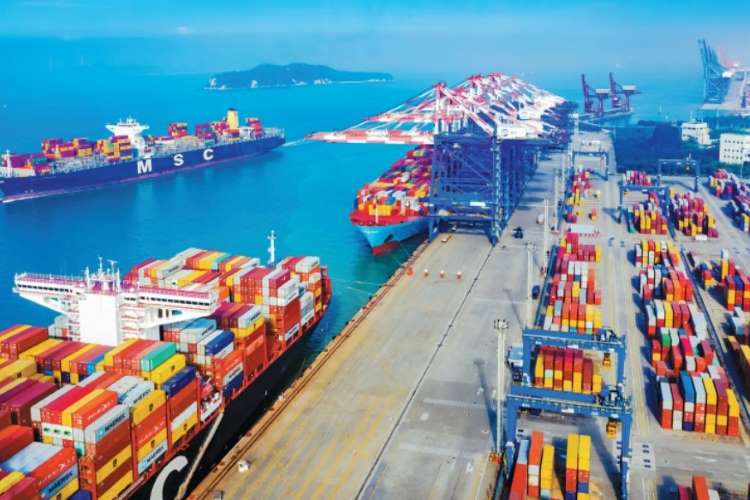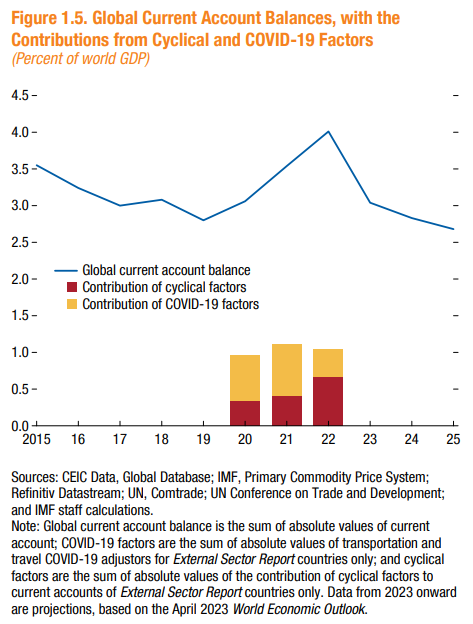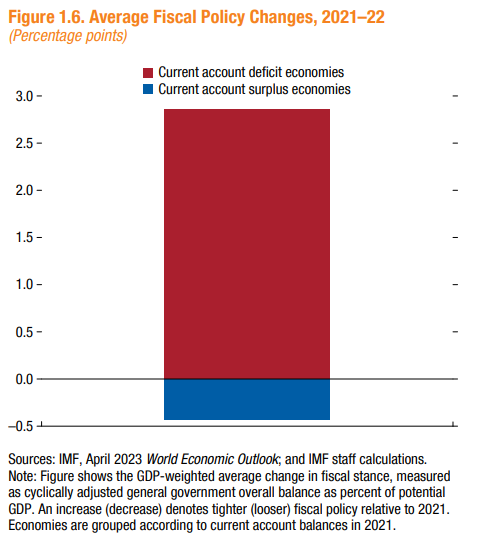
India’s external sector refers to the country’s interactions with the rest of the world in terms of trade, investments, and financial flows. The IMF’s External Sector Report provides an assessment of India’s external position and vulnerabilities as of fiscal year 2022/23 (ending in March 2023) and suggests potential policy responses to address any imbalances or risks.
The current account is a key component of the external sector and represents the balance of trade in goods and services, net income from abroad, and net current transfers. India’s CA deficit was moderately stronger in 2022/23 than what could be justified by its medium-term fundamentals and desirable policies.


This suggests that the CA deficit was smaller than expected given India’s per capita income, favorable growth prospects, demographic trends, and development needs. However, India’s external vulnerabilities arise from weakening demand in some partner countries, volatile global financial conditions, and fluctuating commodity prices.
To address these vulnerabilities, India needs to focus on external rebalancing over the medium term. Potential policy responses include fiscal consolidation, developing export infrastructure, negotiating free trade agreements with main trading partners, liberalising the investment regime, and reducing tariffs, especially on intermediate goods. Structural reforms that promote integration into global value chains and attract foreign direct investment (FDI) can also help mitigate external vulnerabilities. Exchange rate flexibility is recommended as the primary shock absorber, with limited intervention in addressing disorderly market conditions.
READ I India reduces multidimensional poverty, but malnutrition remains a concern
Net international investment position
The NIIP represents the difference between a country’s external assets and liabilities. As of the end of 2022, India’s NIIP improved marginally to -11.1 percent of GDP, indicating that the country’s external liabilities exceeded its external assets. The bulk of India’s foreign assets were in the form of official reserves and FDI, while foreign liabilities were mainly in the form of debt and FDI.
Over the medium term, the NIIP-to-GDP ratio is expected to remain broadly unchanged, as robust nominal GDP growth will offset the decline in the nominal NIIP resulting from projected CA deficits and valuation changes. India’s external debt liabilities are relatively low compared to its peers, and short-term rollover risks are limited. The country’s incremental approach to capital account liberalisation has primarily focused on attracting FDI.
Current account deficit and exchange rate
The CA deficit widened to 2.0 percent of GDP in fiscal year 2022/23 due to a high fiscal deficit. Imports rebounded faster than exports as pandemic restrictions were lifted, leading to a surge in domestic demand and rising commodity prices after Russia’s invasion of Ukraine. The CA deficit is projected to narrow to about 1.8 percent of GDP in fiscal year 2023/24, mainly due to expected declines in oil import costs. Over the medium term, the CA deficit is projected to converge to its norm of about 2.4 percent of GDP.
The IMF staff assesses the CA gap to be 1.5 percent of GDP, with a range of 0.8 to 2.1 percent of GDP. Positive policy contributions to the CA gap mainly come from the domestic credit gap, while negative contributions come from changes in foreign exchange reserves and capital controls. The exchange rate flexibility is seen as a crucial mechanism to absorb shocks, and the IMF recommends limited intervention in the foreign exchange market to address any disorderly market conditions.
Real exchange rate
The REER is a measure of the value of a country’s currency relative to a weighted average of foreign currencies, adjusted for inflation differences. In the first half of 2022, depreciation pressures were observed on the Indian rupee due to widening CA deficit and portfolio investment outflows. However, these pressures abated and reversed as the CA deficit narrowed and investor sentiment improved in the second half of 2022 and early 2023.
The IMF staff assesses the REER gap to be in the range of -11.4 to -4.2 percent, with a midpoint of -7.8 percent, for fiscal year 2022/23. This suggests that the Indian rupee may be somewhat overvalued, and measures to improve export competitiveness may be warranted.
Capital and financial accounts
India experienced stable net FDI inflows of about 1 percent of GDP in fiscal year 2022/23. Volatile portfolio investments recorded small net outflows, while other investments, mostly debt-creating inflows, moderated. The Indian authorities made further steps toward capital account liberalisation by increasing limits on external borrowing and widening the scope of government bonds available for foreign investors.
To promote FDI, further structural reforms and improvements in the investment regime are needed. Additionally, India’s inclusion in international bond indices could attract more foreign participation in the bond market, supporting portfolio inflows to finance the CA deficit over the medium term.
Foreign exchange reserves
India’s official foreign exchange reserves decreased in the first half of 2022 but increased later in the year as the CA deficit narrowed and investor confidence improved. As of the end of 2022, reserves stood at $562.7 billion, which the IMF considers adequate for precautionary purposes.
The reserves represented about 198 percent of short-term debt (on residual maturity), 159 percent of the IMF’s composite metric, and approximately seven months of import coverage. Given India’s moderately strong external position and adequate reserves level, the IMF recommends limiting foreign exchange interventions to address disorderly market conditions.
India’s external sector shows some strengths, such as a moderately stronger external position than expected and relatively low external debt liabilities. However, vulnerabilities remain due to weakening demand in certain partner countries and volatile global financial conditions.
To address these challenges, the country should focus on external rebalancing through policy measures like fiscal consolidation, export infrastructure development, liberalisation of investment regimes, and exchange rate flexibility. These measures, combined with structural reforms to attract FDI and promote exports, can help strengthen India’s external sector resilience.
(This article is written using AI inputs.)

